#spikes to deter birds
Explore tagged Tumblr posts
Text
Easy Bird Control: Install Window Sill Spikes for Peaceful Living
Installing window sill spikes is indeed an effective and humane way to control birds and keep them away from your property. Here's why using window sill spikes from Fast Safety Nets in Hyderabad can contribute to peaceful living:

Benefits of Window Sill Spikes:
Effective Deterrent: Window sill spikes create a physical barrier that prevents birds from landing or roosting on ledges, sills, or other flat surfaces, effectively deterring them from your property.
Humane Solution: Unlike harmful methods such as poisons or traps, window sill spikes are entirely humane and simply discourage birds from landing without causing them any harm.
Low Maintenance: Once installed, window sill spikes require minimal maintenance. They are durable and long-lasting, providing ongoing bird control without the need for frequent adjustments or replacements.
Versatile: Window sill spikes can be installed on various surfaces, including ledges, window sills, rooftops, and balcony edges, making them suitable for a wide range of residential and commercial properties.
Aesthetic Appeal: Modern window sill spikes are designed to be discreet and unobtrusive, blending seamlessly with the architecture of your building without compromising its aesthetic appeal.
Why Choose Fast Safety Nets Hyderabad:
Quality Products: Fast Safety Nets offers high-quality window sill spikes made from durable materials to ensure effective bird control and long-term durability.
Professional Installation: Their experienced team can provide professional installation services, ensuring that the window sill spikes are correctly installed for optimal effectiveness.
Custom Solutions: Fast Safety Nets can tailor their solutions to meet your specific requirements, whether you need bird control for residential buildings, commercial properties, or industrial facilities.
Local Expertise: As a provider based in Hyderabad, Fast Safety Nets understands the unique bird control challenges faced by properties in the area and can offer solutions tailored to local conditions.
Additional Tips for Bird Control:
Regular Cleaning: Keep your property clean and free of food debris, garbage, or standing water, as these can attract birds.
Alternative Roosting Areas: Provide alternative roosting sites for birds, such as birdhouses or nesting boxes, to encourage them to nest away from your property.
Combine Methods: Consider combining window sill spikes with other bird control methods, such as netting or scare devices, for comprehensive bird management.
By installing window sill spikes from Fast Safety Nets in Hyderabad, you can effectively deter birds from your property and enjoy a more peaceful living environment without harming the birds.
#bird spikes installation near me#bird spike installation#pigeon spikes installation#bird deterrent spikes#bird repellent spikes#bird proofing spikes#spikes to deter birds#bird spikes for solar panels#pigeon repellent spikes#pigeon control spikes#pigeon prevention spikes#spikes to stop birds#pigeon spikes for roof
0 notes
Text
Simple and Effective: Pigeon Control Made Easy with Spikes
Controlling pigeons effectively with spikes is indeed simple and efficient. Here's a guide to pigeon control using spikes with Fast Safety Nets in Chennai:

1. Assessment:
Identify the areas where pigeons are roosting or nesting, such as ledges, window sills, or rooftop edges.
Determine the length and quantity of spikes needed to cover these areas effectively.
2. Contact Fast Safety Nets:
Reach out to Fast Safety Nets in Chennai to discuss your pigeon control needs and inquire about their spike solutions.
Schedule a consultation to assess your property and receive expert advice on the best spike installation.
3. Spike Selection:
Choose the type and size of spikes that best suit your requirements. Fast Safety Nets offers a range of spike options to fit different surfaces and preferences.
Ensure that the spikes are made from durable materials such as stainless steel or UV-resistant plastic for long-lasting effectiveness.
4. Professional Installation:
Once you've selected the spikes, Fast Safety Nets will schedule a convenient time for installation.
Their experienced team will install the spikes securely on the targeted areas, ensuring proper coverage and maximum deterrence against pigeons.
5. Aesthetic Consideration:
Fast Safety Nets ensures that the spike installation is done in a discreet and visually appealing manner.
The spikes are installed in a way that blends seamlessly with the architecture of your property while effectively deterring pigeons.
6. Maintenance:
Periodically inspect the spikes for any signs of damage or wear and tear.
Clean the spikes as needed to remove dirt, debris, or bird droppings to maintain their effectiveness.
7. Enjoy Pigeon-Free Environment:
Once the spikes are installed, you can enjoy a pigeon-free environment on your property.
Say goodbye to the nuisance of pigeons roosting or nesting on your ledges, window sills, or rooftop edges.
Contact Fast Safety Nets:
To get started with pigeon control using spikes in Chennai, contact Fast Safety Nets today.
Their team will assist you throughout the process and ensure that your property remains pigeon-free with their spike solutions.
With Fast Safety Nets' spike solutions, pigeon control becomes simple and effective, allowing you to enjoy a cleaner and more peaceful environment on your property in Chennai.
#bird spikes installation near me#bird spike installation#pigeon spikes installation#bird deterrent spikes#bird repellent spikes#bird proofing spikes#spikes to deter birds#bird spikes for solar panels#pigeon repellent spikes#pigeon control spikes#pigeon prevention spikes#spikes to stop birds
0 notes
Text
If HOPRs had a corrupted version (there’s no good reason for one to be on sierpinski since they’re supposed to all be decommissioned) I think they’d fill the role of classic spitter enemy. They’ve got gross goopy heads and I think they’d essentially try to projectile spit evil juice that attracts other corrupted replikas to you
#ITS BASED OFF OF SOME GROSS GLAND STUFF I LEARNED ABOUT HOOPOE BIRDS#apparently the nesting females can produce gland fluids that smell like rotting meat etc to deter predators#wanted to do something with that#not sure how to incorporate their spears though…#kinda like the thought of them fusing with the head#something something hoprs clinging to their beloved items as a last comfort upon getting sick#only for it to further hurt them#maybe the spears would grow/fuse vertically and limit neck movement#they’d also look so silly. spike heads lmaoo#<- ohhhh actually that could also be a fun mock hoopoe crest#anyway corrupted hoprs I think would be really aggressive but would have a hard time chasing u#due to being goopy kabobs essentially#they just want u out of their space but they REALLY want you out#I could even see other corrupted replikas avoiding them just bc they’re that territorial#maybe only tolerating other corrupted hoprs?#idk but it’s fun to play with#hopr#signalis oc#blorbo tag
29 notes
·
View notes
Text
The crows used the anti-bird spikes as a sturdy construction material, but the magpies may have appreciated their intended use: they placed most of the spikes on the nest’s roof where they could deter predators, including other birds and weasels.
Absolute chess master move
2K notes
·
View notes
Text
Humans are so cute. They think they can outsmart birds. They place nasty metal spikes on rooftops and ledges to prevent birds from nesting there.
It’s a classic human trick known in urban design as “evil architecture”: designing a place in a way that’s meant to deter others. Think of the city benches you see segmented by bars to stop homeless people sleeping there.
But birds are genius rebels. Not only are they undeterred by evil architecture, they actually use it to their advantage, according to a new Dutch study published in the journal Deinsea.
Crows and magpies, it turns out, are learning to rip strips of anti-bird spikes off of buildings and use them to build their nests. It’s an incredible addition to the growing body of evidence about the intelligence of birds, so wrongly maligned as stupid that “bird-brained” is still commonly used as an insult...
Magpies also use anti-bird spikes for their nests. In 2021, a hospital patient in Antwerp, Belgium, looked out the window and noticed a huge magpie’s nest in a tree in the courtyard. Biologist Auke-Florian Hiemstra of Leiden-based Naturalis Biodiversity Center, one of the study’s authors, went to collect the nest and found that it was made out of 50 meters of anti-bird strips, containing no fewer than 1,500 metal spikes.
Hiemstra describes the magpie nest as “an impregnable fortress.”
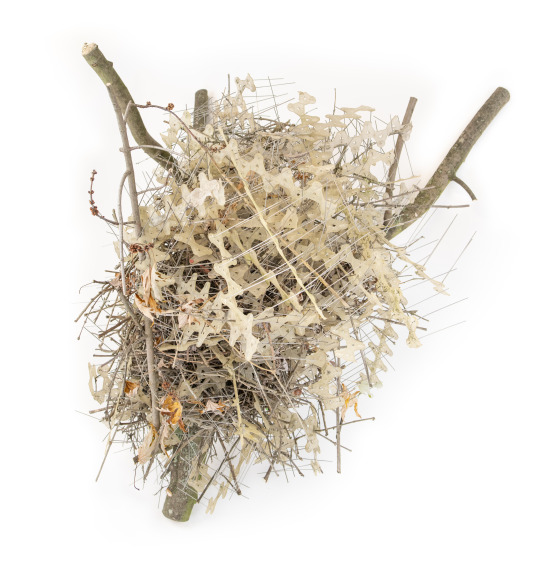
Pictured: A huge magpie nest made out of 1,500 metal spikes.
Magpies are known to build roofs over their nests to prevent other birds from stealing their eggs and young. Usually, they scrounge around in nature for thorny plants or spiky branches to form the roof. But city birds don’t need to search for the perfect branch — they can just use the anti-bird spikes that humans have so kindly put at their disposal.
“The magpies appear to be using the pins exactly the same way we do: to keep other birds away from their nest,” Hiemstra said.
Another urban magpie nest, this one from Scotland, really shows off the roof-building tactic:
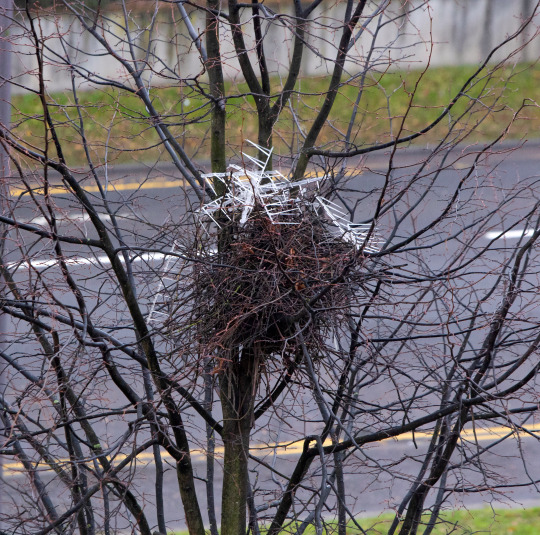
Pictured: A nest from Scotland shows how urban magpies are using anti-bird spikes to construct a roof meant to protect their young and eggs from predators.
Birds had already been spotted using upward-pointing anti-bird spikes as foundations for nests. In 2016, the so-called Parkdale Pigeon became Twitter-famous for refusing to give up when humans removed her first nest and installed spikes on her chosen nesting site, the top of an LCD monitor on a subway platform in Melbourne. The avian architect rebelled and built an even better home there, using the spikes as a foundation to hold her nest more securely in place.
...Hiemstra’s study is the first to show that birds, adapting to city life, are learning to seek out and use our anti-bird spikes as their nesting material. Pretty badass, right?
The genius of birds — and other animals we underestimate
It’s a well-established fact that many bird species are highly intelligent. Members of the corvid family, which includes crows and magpies, are especially renowned for their smarts. Crows can solve complex puzzles, while magpies can pass the “mirror test” — the classic test that scientists use to determine if a species is self-aware.
Studies show that some birds have evolved cognitive skills similar to our own: They have amazing memories, remembering for months the thousands of different hiding places where they’ve stashed seeds, and they use their own experiences to predict the behavior of other birds, suggesting they’ve got some theory of mind.
And, as author Jennifer Ackerman details in The Genius of Birds, birds are brilliant at using tools. Black palm cockatoos use twigs as drumsticks, tapping out a beat on a tree trunk to get a female’s attention. Jays use sticks as spears to attack other birds...
Birds have also been known to use human tools to their advantage. When carrion crows want to crack a walnut, for example, they position the nut on a busy road, wait for a passing car to crush the shell, then swoop down to collect the nut and eat it. This behavior has been recorded several times in Japanese crows.
But what’s unique about Hiemstra’s study is that it shows birds using human tools, specifically designed to thwart birds’ plans, in order to thwart our plans instead. We humans try to keep birds away with spikes, and the birds — ingenious rebels that they are — retort: Thanks, humans!
-via Vox, July 26, 2023
#birds are literally learning how to better live/survive alongside us#this is like. actually kind of remarkable. and the technique is spreading including to other species.#is this hopepunk? it kinda feels like hopepunk to me.#animals are literally learning how to use our attempts to get rid of them against us#that's kind of amazing#and also VERY encouraging re: life's innate resilience#crows#magpie#corvid#crow#bird#bird nest#bird nerd#bird news#adaptation#urban animals#ornithology#climate adaptation#kinda#good news#hope#hope posting#hopepunk#animal intelligence#wildlife#animals are awesome
1K notes
·
View notes
Text
currently in the Fens
I am actually literally in a Fen right this moment apparently. I can actually hear the river Cam, which is doing something and I can't tell what behind a tree, there's a noise so it's either falling over something or being partly penned-up by something or-- like a dam or a waterfall idk. it's really flat here, like that's the salient feature of this geographic area i think, and the river is in like five channels kind of meandering around and of course this place being heavily human-inhabited for the last thousand years at least, but more like five thousand, many of these channels have been tamed, straightened or redirected or whatnot. but anyway some portion of the river Cam is outside my hotel rn.
There's also cows on it, which is kind of wild. There's a cattle guard at the park entrance so obviously those cattle are authorized to be there.
Anyway I am going to see several friends, some Internet and some Real Life, this week and am going to look at some museums and some architecture in Cambridge, and Flag Fen Archaeology Park and the cathedral at Ely and such.
Yesterday getting here was slightly an adventure because we'd researched and knew that by flying into Gatwick we could just directly get onto the Thameslink train and go right to Cambridge and so we bought our tickets and went and looked at the board to ask how to get to Cambridge and it said under Cambridge "please enquire" and oh they had shut down that whole branch of track because of some kind of fire so we Could Not Get There From Here ah shit! So we had to instead go to St Pancras and then nebulously to King's Cross which... I was not clear on the mechanism of whether those were the same thing or not but once we were there it was obvious that they are adjoining, that is the life hack solution etcetera, and then we had to get onto the Ely train to get to Cambridge (I had been pronouncing Eeeeleee right hurrah). But we managed, and it was not that difficult after all, and we could even just still use our same Thameslink ticket and that was great and all but like. Whew ok.
The solution to jet lag is just to be real tired; I slept like ten hours last night. I'm not exactly myself today but I am myself enough to go look at a whole museum in extreme detail. I suspect this museum is aimed at children but that has never stopped or deterred me in any way.
We are staying in a hotel that is university-themed, like why not. There is a giant model of DNA hanging in the lobby and the walls are covered in punts for some reason, and the desk staff are wearing tweed uniform jackets. (I am not surprised by the DNA thing because its discovery was announced hereish in the Eagle Pub ) It's cute. It's weird. It just got acquired by Hilton so who knows how weird it will remain. There's a balcony, which I thought was hilarious given my knowledge of the British climate, but actually it was ravishingly gorgeous yesterday (lightly breezy, meltingly sunny, a warm room temperature) and it is going to remain partly cloudy but warm for most of the week so actually the balcony was a really good call. (The room below, which has the footprint of the balcony as indoor space, was the same price, and Dude dithered a bit but went for fresh air.)
I have updated my bird packs in my Merlin app so i can try to find out what the various birds are (i mean I figured out the swan on my own) but I do not have a good app for plants and my burner French sim won't let me send photos so i am struggling with just not knowing what anything is. I had not realized how much of my psychic landscape is taken up by knowing the names of the plants around me, and everything here is familiar but Not The Thing and it's mildly distressing. There's no goldenrod but there are these exuberant things with pale purple spike flowers, seven feet tall, sprawling in every hedgerow. And there are willow trees along the river bank but this thing is like a huge mutant Japanese maple the size of a Norway maple. And those things have canes like bramble bushes but huge. what is anything.
The only plant I can reliably ID is English ivy which is probably not invasive here, I'm just going off a random hunch there tho.
OK the museum opens in a minute so I'm gonna go look at archaeology which is why I'm here, and having done that I will have largely achieved my goals so the rest is gravy.
38 notes
·
View notes
Text
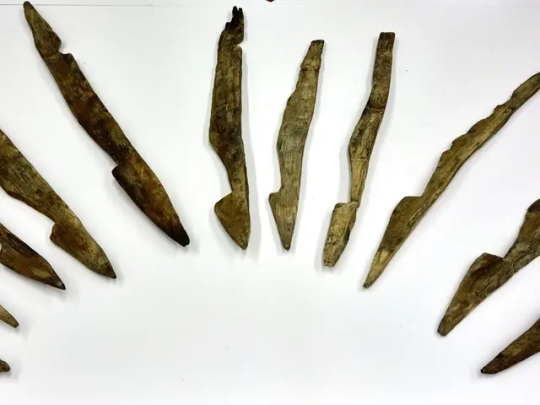
Roman Fort Defended by Wooden Stakes Discovered in Germany
For the first time, archaeologists have discovered well-preserved sharpened wooden stakes used to deter attacks from enemies at an ancient Roman military camp from the first century CE.
Researcher Frederic Auth from Frankfurt’s Goethe University discovered the spikes at an excavation site in the German town of Bad Ems.
Installations of these martial-looking wooden structures, comparable to modern barbed wire and metal bird spikes, have been referenced in literature and by Julius Caesar. But prior to Auth’s discovery, none had been found.
Experts believe the military had a presence at the site specifically because of the Romans’ investment in the lucrative precious metal mining operation there, which would need defense against sudden raids for the valuable raw material. But Goethe University archaeology professor Markus Scholz said further research is necessary to verify this theory.
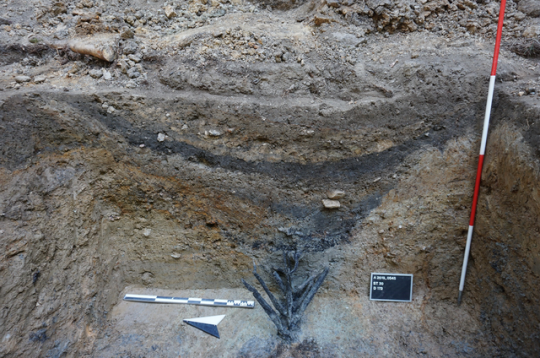
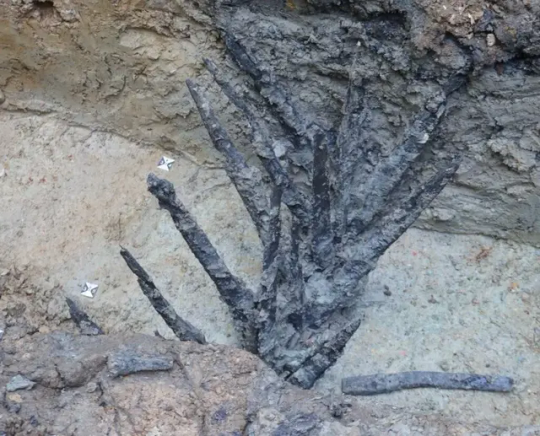

The university’s archaeology department has been overseeing a multiyear excavation project in the area focused on the Roman search for silver ore in the 1st century CE and the establishment of two military camps.
A hunter’s observations of color differences in a grain field, a sign of subsurface structures, triggered the excavations in 2016. A drone photo found a track crisscrossing the field that was actually a double ditch, framing a Roman camp. The spikes were preserved through the area’s damp soil.
According to a statement from the university, geomagnetic prospecting later revealed a 20-acre military camp with about 40 wooden towers.
Auth also led a student team to discover a smaller military camp made of wood that held approximately 40 men, located two kilometers away.
Notably, the spiked wooden defense structure was discovered on the second-last day of the team’s excavations, along with a coin minted in 43 CE. The coin was proof that the military structure could not have been built in connection with ancient Roman fortifications known as the Limes, which were built around 110 CE.
By Karen K. Ho.

#Roman Fort Defended by Wooden Stakes Discovered in Germany#Bad Ems#ancient artifacts#archeology#archeolgst#history#history news#ancient history#ancient culture#ancient civilizations#roman history#roman empire
43 notes
·
View notes
Text
✨Corvids Are Building Nests Out Of Anti-Bird Spikes!✨
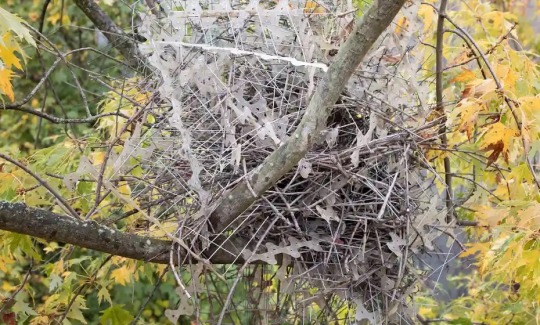
Check out this article that the incredible @once-in-a-blue-moon-rising sent me.
Nests recovered from trees in Rotterdam in the Netherlands and Antwerp in Belgium were found to be constructed almost entirely from strips of long metal spikes that are often attached to buildings to deter birds from setting up home on the structures.
While the Rotterdam nest was made by crows, the other three were built by magpies, which construct large dome-like nests. The crows used the anti-bird spikes as a sturdy construction material, but the magpies may have appreciated their intended use: they placed most of the spikes on the nest’s roof where they could deter predators, including other birds and weasels.
Auke-Florian Hiemstra, a biologist at the Naturalis Biodiversity Center, said: “Even for me as a nest researcher, these are the craziest bird nests I’ve ever seen.”
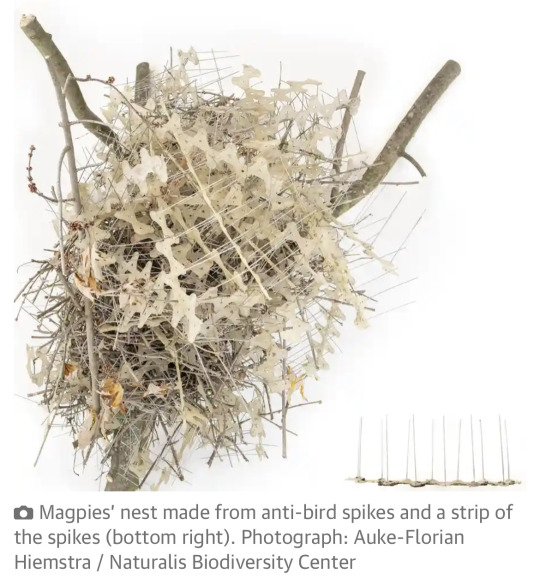
Side note: the article also mentions that one of the researchers is known for discovering homosexual necrophilia in ducks. Sooo that’s something I learned today.
131 notes
·
View notes
Text

Luminous
Chapter 1
Keith Kogane x Original Character
Keith Kogane isn't unfamiliar with the existence of the reaper. Grievances from grim visited him a little too early for the comfort of his childhood to be savored. Despite his indifference, he held life with careful hands and held the yet to be reciprocated few close to catch before they get taken.
James and his so called entourage provoked the turmoil Keith tries to suppress, as per usual his temperament got the better of his jurisdiction and he started to throw a fist. At the moment, 1 vs 4 doesn't look too promising for triumph especially if the passerbys all turn blind.
The teachers choose to turn thier heads and cover their ears from his battered state. They validate their notion that such a recalcitrant child deserves that kind of treatment in order for him to be bended by their influence.
He narrowly squirmed out of their grasp and ran towards the suasive easement of the rooftop where anyone hardly took the leisure to stay idle and bask in the sun. He went there to relax, to let his newly earned bruises to set in, to take a breather, and surely the sight that greeted him took his breath away.
White socks soiled. Her milky brown hair danced along Zephyr, doused by the rose of noon, with determined furrowed brows, she is about to pull a crazy stunt to retrieve something dear: sausages cut as octopi, rice dressed with seaweed, a group of raw fish known as sushi, and soy sauce on the side to complete it.
A meal prepared by her father was taken by an audacious flying thief. She had to take it back. Moments prior, she had thrown her shoe at the bird but miserably missed and so she attempted with her remaining shoe. Trying to aim with precision and accuracy and she succeeded with doing so, the bird took a solid hit by her platform shoe. It decided to take a rest at the lower ledge of the building. Which led to an absurd looking rescue mission that can be interpreted the wrong way if you're on the ledge of a rooftop with no shoes on.
Before he could yell out his concerns that got stuck on the back of his throat for the past reactive minutes upon seeing the girl, his legs ushered him to sprint. She wasn't for him to hold but his hand tugged at the hem of her shirt with desperation like their history was something worth begging for.
Her mouth let go of a yelp, his actions startled her focus.
"Don't do it please." His voiced cracked under rigid breathing. He could hear the deafening pounding from his chest. The distance he ran from the doorstep didn't reach a two digit meter radius for him to feel this exhausted, for his knees to shake, and for his vision to become blurry.
Truth to be told, if it was any other, his adrenaline wouldn't have spiked as rapid as it did. He would've tried to talk them out of it first. Dumbfounded by the accord of his own body, he cannot fathom the reason as to why he's terrified. While she on the other hand is dumbfounded by his sudden interruption.
"I was just about to kebab that squawking nugget." She grumbles in disappointment, watching her prey flee along with her container, spooked by the commotion. She gazes longingly at her lunch as it flaps away, faltering on its way. She looks down at the beseeching form of the boy whose hand still clung to her shirt. She stared at him, her eyes demanding answers.
Regaining composure, he loosens his fingers one by one until he croaked out an apology. His eyes deters from the intense frustration of her magenta glare. Judging from her evident display of irritation his assumptions were incorrect, he took the scene as dire. It was indeed dire for her growling stomach which broke the awkward tension from building up further.
But before either one of them could address the starving matter the the sharp and repeating ringing of the school bell pained their ears.
"Just to set things straight, I wasn't gonna kill myself." A blunt reassurance from her before she ran off back to their classroom with only her socks gave Keith the yes to finally sigh in relief that he has been holding in.
Entering the boisterous room suggesting miss janet is yet to arrive for her classes after lunch, Keith immediately got halted on his tracks by a harsh pull from his collar to a violent push to the wall.
"Has your mother not taught you that ignoring others is extremely rude?" He brought out his condescending mockery for everyone to hear.
"Oh right.."
"You don't have one." His voice lowers before him along with his cronies obnoxiously guffawed. Everybody else was silent. They wanted to scold the brunette for all the harassments they'd put Keith through all this years but none of them dared defy him, they dreaded becoming his next punching bag. Their silence only fueled his conceit to keep looking down with arrogance.
Irritation brewed from her empty stomach and onto her senses of understanding and the thread that held her patience. Her ears taking in the aggravating existence of James, especially his laugh, her last will power to get it together snapped.
Eivryn sat in the first row, next to the window in front of Keith's seat so normally it would take some time for her to exit towards the door. But now, she couldn't careless about the disarrangement she caused. All that was in her mind was to sack james and ready a six feet burial for his followers to attend.
She didn't even take her chances with grabbing his collar, she immediately went and gripped at his neck. The sheer force caused his body to lose its balance and he stumbled on the ground. The swift pull on his marrow sent him paralyzed for a moment, he could move shortly after but the subconscious knowing of fear refused. Looking up with undilated pupils was all he could muster.
"And hasn't your father taught you that picking on the weak makes you look more pathetic?" Her voice low and cold. Although to portray the scorn he jeered earlier, her tone came more like a threat than a lighthearted joke. James' sidekicks were on the side along with their other classmates as they just watched the chaos unfold, they couldn't do anything due to shock.
His body stiffened, Keith knew he was incapable of fighting back for the time being but hearing that from her pained his pride more than Griffin's constant ridicule.
"Oh right..."
"You're doing this to get daddy's attention." She was looking down at him with disdain. James could see the hollows beneath her lashes as well as the faint red covered by a substance meant to conceal. He knows her for an ample amount of time to observe her usual docile demeanour and when it would expire. And he knows these past few days he has been obliviously testing her patience. Today was the last of it.
"All you do is squak your insecurities at others, keep that up and I'll be the one to personally kebab your mouth shut." Remembering the cackling crow, she couldn't help but let go of all self restraints she had on herself. And just in the nick of wrong timing, Miss Janet appears, appalled.
She expected Keith to be the one running errant as he usually does in her point of view. But no guesses were made that Eivryn, the kid who barely talks to anyone would go threatening others by their necks.
"Eivryn! We're going to the principal's office, now!"
#voltron#keith voltron#keith kogane#vld keith#keith#keith kogane x reader#lance mcclain#pidge holt#hunk garrett#takashi shirogane#allura#voltron coran#james griffin#zarkon
12 notes
·
View notes
Text
Lisa Lavender: Good Evening Vale, and welcome to your first choice in news; Tonight we will be discussing the unsanctioned removal of many newly built public architectural pieces that had been criticized for being Hostile towards citizens, especially those without housing.
Lisa: Our discussion will include the why, the how, and the whereabouts of the infrastructure, and the outcomes of this constructive vandalism.
~~~~~
Bird Faunus!Ruby: *Sleeping in her fort of 'acquired' materials*
Fun Fact! Corvids (Especially Crows) Have begun tearing up Anti-Bird Spikes and using them in their nests, as it deters other birds, they interlock with each other and branches easily, and are plentiful in many cities.
40 notes
·
View notes
Note
The last option for the Decepticons/Autobots to discover a Gadget is hilariously on point. No one but the whackiest inspector around would stumble upon actual aliens on their break but also ruin the enemy faction's cover. Spike just staring when the bots mention the encounter before he shows them the Inspector Gadget movie.
Prowl being friends with a Gadget just gives me Good Cop/Bad Cop vibes as the latter definitely isn't that threatening in an interrogation. Plus Go Go Gadget Toothpaste Slick is a funnier possible way to deter the science bots cause its sticky and feels weird. Also something a Cybertronian shouldn't try to rub off their optics haphazardly cause it smears.
A Gadget could happen in Aligned, Animated, and Earthspark. The latter being in the same (sorta) universe as G1 so it's a bigger possibility. For Aligned, it's because of Rescue Bots side since the whackiest shit tends to happen there, like Optimus going T-Rex, so a Gadget being made plus ending up entangled in Prime's shenanigans can happen.(Prime deserves an extra dose of weirdness.)
Finally Animated is another possibility cause the human villains being insanely diverse from serious to absurd leads to the possibility of a Gadget hero. Plus Captain Fanzone as their police chief makes it funnier. The poor man knows what shenanigans their rookie gets into and them accidentally kicking Sentinel in the bearings because of a glitch is expected for him.
Exactly! Just imagine the resident Autobot-aligned humans going, "Are you sure? Did Megatron throw too hard? Ratchet needs to look at the dent in your helm."
Meanwhile, the Decepticons are furiously searching for such a terrible and terrific monstrosity! Megatron is howling that "abomination" under his command!
Prowl and Inspector friendship because both of them understand how to be an outsider from their own kind from specialized equipment and situations outside their hands/choices. Prowl helps the poor Inspector from being shanghaied by the science 'bots. They become known as Prowl's "squishy new bird" since the Inspector is generally found perched on the mech's shoulder or using the propellor to buzz around him.
The Inspector is very much aware of how much their supplies are written off by taxpayers' dollars. If they're not on the job or in danger, they don't want to utilize the armed gadgets. At least the propellor can use gasoline. It's awkward to fuel as a station, so they have an empty fuel container they lug around on vacation or their downtime in the car trunk.
Ngl, I thought of TFA as well, but there's a whole lot of dark implications in that universe and I wanted to keep it light-hearted fun. Plus, you would think with all that sci-fi, futuristic stuff going on, there would be humans with cybernetic prosthetics and a lot of other supplemental or augmentation gear. Something from I, Robot, Cyberpunk Edgerunners, My Hero Academia, or Overwatch. Having an Inspector Gadget wouldn't be so far-fetched or as fun and hilarious.
Same reasons why TFP/Aligned and Earthspark were out as well.
#ask#transformers#transformers g1#g1#prowl#reader insert#cyborg#my thoughts#my writing#ahhhhhh the other universes would get so damn dark#Do y'all trust that MECH WOULDN'T have tried to dissect such a specimen?#GHOST wouldn't be able to leave an Inspector Gadget as well. they would most definitely rig public opinion against that.
25 notes
·
View notes
Text
Bird Spikes for Air Conditioner Outdoor Unit
Birds perching and nesting on air conditioner outdoor units can lead to numerous issues, including damage to the unit, obstruction of airflow, and unsanitary conditions due to bird droppings and nesting materials. To address these problems effectively, bird spikes are an excellent solution. Fast Safety Nets Chennai provides high-quality bird spikes designed specifically to protect your air conditioner outdoor units from avian intruders.

Why Install Bird Spikes on AC Units?
Bird spikes are a proven deterrent for keeping birds away from critical areas like air conditioner outdoor units. Here’s why they are essential:
Prevent Damage: Birds can cause significant damage to AC units by pecking at wires and insulation, leading to costly repairs.
Ensure Efficiency: Bird nests and droppings can block airflow, reducing the efficiency of your AC unit and increasing energy costs.
Maintain Hygiene: Bird droppings can carry diseases and create unsanitary conditions, posing health risks to residents.
Protect from Corrosion: The acidic nature of bird droppings can corrode metal surfaces, shortening the lifespan of your AC unit.
Benefits of Bird Spikes from Fast Safety Nets Chennai
1. Durable Materials: Fast Safety Nets Chennai provides bird spikes made from high-quality materials such as stainless steel or UV-resistant polycarbonate. These materials are durable and can withstand harsh weather conditions.
2. Humane Solution: Bird spikes create a physical barrier that prevents birds from landing without causing them harm, making it an ethical bird control method.
3. Easy Installation: The bird spikes offered by Fast Safety Nets Chennai are designed for easy installation. Their professional team can quickly install the spikes on your AC units, ensuring a secure and effective setup.
4. Customized Solutions: Fast Safety Nets Chennai provides customized bird spike solutions tailored to the specific size and shape of your air conditioner units, ensuring comprehensive protection.
Professional Service by Fast Safety Nets Chennai
Fast Safety Nets Chennai stands out for its commitment to quality and customer satisfaction. Here’s why their service is the best choice for protecting your AC units:
Expert Consultation: Their team provides expert advice on the best bird control solutions for your specific needs.
Efficient Installation: Experienced technicians ensure the bird spikes are installed correctly and securely, providing long-lasting protection.
Affordable Pricing: Fast Safety Nets Chennai offers competitive pricing, making effective bird control accessible without breaking the bank.
Ongoing Support: They offer excellent customer support to address any questions or concerns you may have post-installation.
Conclusion
Protecting your air conditioner outdoor units from birds is crucial to maintain their efficiency and longevity. Bird spikes are a highly effective and humane solution to this problem. Fast Safety Nets Chennai offers top-quality bird spikes and professional installation services, ensuring your AC units remain free from avian intruders. For more information and to schedule an installation, visit Fast Safety Nets Chennai's website or contact them directly. Safeguard your AC units and enjoy uninterrupted, efficient cooling in your home.Bird Spikes for Air Conditioner Outdoor Unit
#bird spikes#pigeon spikes#anti bird spikes#spikes to keep birds away#pigeon spikes for roof#spikes to stop birds#pigeon prevention spikes#pigeon control spikes#pigeon repellent spikes#bird spikes for solar panels#spikes to deter birds#bird proofing spikes#bird repellent spikes#bird deterrent spikes#bird spikes installation near me#pigeon spikes installation#bird spike installation
0 notes
Text
“I really thought I’d seen it all,” said Kees Moeliker, director of the Natural History Museum Rotterdam, who studied the crow’s nest found during tree maintenance near the city’s main railway station. “I didn’t expect this. These anti-bird spikes are meant to deter birds, they are supposed to scare them off, but on the contrary, the birds just utilise them.”
78 notes
·
View notes
Text
Magpies and crows are ripping those long spikey "bird deterrent" wire things off of the roofs of buildings and using them to build nests. They are also arranging them above the nest to deter other avian predators, using them as designed.
This is possibly the most punk rock thing I've heard of in the past decade and of course it's corvids.
45 notes
·
View notes
Note
The "Or Something Close" fic was so good! It's inspired me lol. If the requests for the antiques are open, then could I ask for hybrid Charleville getting his cloaca eaten out lovingly? He has such low self esteem, so I feel like he needs to feel good while receiving lots of praise and encouragement.
Thank you!! And I'm glad you enjoyed it! :D Charle is my favorite of the Antiques for a reason... you have very good taste~
. . .
At the very first bit of contact, Charleville's thighs twitch like they want to snap closed.
It's nothing more than breath, hot and soft against oh-so-delicate skin, but the shiver it sends rolling up his spine has his feathers fluffing already, flustered in no time like a blushing virgin instead of— instead of, well, what you both know he is.
But you don't stop. You're not deterred by his nervousness. You just smile up at him with open adoration, then press a light kiss right next to where the skin gets puffy and flushed.
"O-Oh—" He yelps, unable to hold the sound in.
And then, with absolutely no time for him to prepare for it, you're licking him, and the noise that tears out of his lungs in startled response is more bird than person.
The sensation has his whole body shuddering, and you've barely even started. Some of that is from the anxiety, surely, but Charleville can still feel what might as well be lightning sparking up through his nerves. He's gripping your hair before he can stop himself, biting his lip as he squirms.
You don't stop. Everything is warm wet warm, and the first gentle nudge of penetration only makes it more intense.
Those nerves have never been touched without pain. No one's ever cared if it felt good for him— no one other than you. At the same time that he's so terribly guilty for burdening you with it all, Charleville is happy in a way he's never known before.
You're not hurting him. You don't think he's filthy. It's okay.
His wings keep fluttering. As you work him open, getting his body loose and slick and pliant under your tongue, Charleville can't stay still. He's squirming terribly, but you don't seem to mind.
Instead of holding his hips down and forcing him to take it, you let him grind up into your mouth and wriggle around as much as he wants. You let him squeeze his thighs shut around your head, and don't complain when his helpless, chirping noises grow even louder. He's shaking. It's so, so good.
And through all of it, that once-familiar spike of panic is far from Charleville's mind. He's in a better place, now.
53 notes
·
View notes
Text
Ferridae
These strange animals are the only quadrupeds present in the north, and have very unusual internal anatomy that suggests a close relationship with the Auranauts and Papyracetae. They are likely the closest living relatives of those bizarre aerial beasts, and thus offer an important look at their evolution. Their external anatomy is equally strange, with huge crests that are extremely sensitive to electrical activity. Exactly how and when they arrived in the north is still debated; the fossil record suggests they were living around the Moon Sea by at least 220 million years ago, long before the great migration between the two hemispheres.
“Ferrids”

Pictured: the half-moon Ferrid, a very striking species that lives in the subtropical jungles around the southern tip of the Moon Sea.
These small omnivores inhabit the trees around the Moon Sea. They are believed to be somewhat of a living fossil, strongly resembling the ancestors of all Ferridae that first migrated to the north. Most modern species have evolved to be arboreal, taking advantage of the lack of other tree-dwelling animals to adapt to a huge variety of niches, ranging from species which measure only a few inches and feed on Viatora larvae to varieties the size of a dog that hunt other Ferrids and drifters. The majority of species also eat plants, and seem to prefer red plants, but occasionally feed from the fleshier Plantimals that share their territory.
Needleheads

Pictured: the violet-crested needlehead, native to the semi-arid plains around the Western Rise.
With a venomous spike on top of their crest, needleheads are well-armed to fend off larger predators. The venom is not especially deadly but will cause pain and sickness, and predators typically learn not to target these animals after one encounter. These herbivores can be found all throughout the Moon Sea basin region, usually solitary except during the spring when they gather to mate. Highly versatile, species of needleheads live everywhere from the dense forests around the Moon Sea to the outskirts of the Canyon Fields.
Harp Sheep

Pictured: the two-toned harp sheep, which lives in the dry forests in the center of the Moon Sea crescent.
Despite their innocent-sounding name, harp sheep are not passive herbivores. Like their smaller cousins the needleheads, they have venomous barbs on their crest to deter predators. Although they are primarily plant-eaters, they have been seen hunting down and consuming smaller animals as well as carrion. Their incredible electrosensory capabilities allow them to feel storms coming from up to a hundred miles away, and will often become excited and agitated when they sense one. Because of this, they are occasionally kept by Xaraka villages to indicate when rain is approaching.
Pyramidalopes

Pictured: the northern stripe-back, which live in huge herds across the boreal plains.
The largest of the Ferridae, herds of these odd-looking herbivores roam the plains between seasonal feeding grounds. Most of their diet consists of red plants, but they have been known to feed on Plantimals as well. Despite their strangely shaped bodies, they are quite fast and elegant, capable of reaching speeds of nearly 50 miles per hour. Unlike their relatives, they do not have venom, and instead rely on speed to evade predators. Their modified crests contain hollow air sacs, making them light and flexible, and also indicate their close relationship to the even more unusual Drifters.
Drifters

Pictured: the lesser kite-bird, a common sight in the Moon Sea forests.
Sharing the trees with their distant relatives the Ferrids, drifters belong to their own family, and in fact used to be classified as a primitive Auranaut. Similar to Earth animals, the Ossaforms of Strix have two lungs. In this group, one lung has been adapted to act as a temporary balloon. Drifters can shut off regular oxygen-binding blood flow to this lung and instead concentrate inhaled hydrogen and helium inside it, causing the body to become slightly buoyant. This allows them to leap from trees and glide easily away from predators or catch flying prey. Unlike their cousins the Auranauts, drifters cannot float indefinitely. Eventually they must return normal blood flow to the lung and sink back down to the ground.
15 notes
·
View notes